2017 TOYOTA TACOMA child seat
[x] Cancel search: child seatPage 38 of 640

381-1. For safe use
WARNING
■SRS airbag precautions
● The SRS front passenger airbag also deploys with considerable force, and
can cause death or serious injury especially if the front passenger is very
close to the airbag. The front passenger seat should be as far from the air-
bag as possible with the seatback adjusted, so the front passenger sits
upright.
● Improperly seated and/or restrained infants and children can be killed or
seriously injured by a deploying airbag. An infant or child who is too small
to use a seat belt should be properly secured using a child restraint sys-
tem. Toyota strongly recommends that all infants and children be placed in
the rear seats of the vehicle and properly restrained. The rear seats are
safer for infants and children than the front passenger seat. ( →P. 51)
●Do not sit on the edge of the seat or
lean against the dashboard.
● Do not allow a child to stand in front of
the SRS front passenger airbag unit or
sit on the knees of a front passenger.
● Do not allow the front seat occupants to
hold items on their knees.
● Do not lean against the door, the roof
side rail or the front, side and rear pil-
lars.
Page 46 of 640
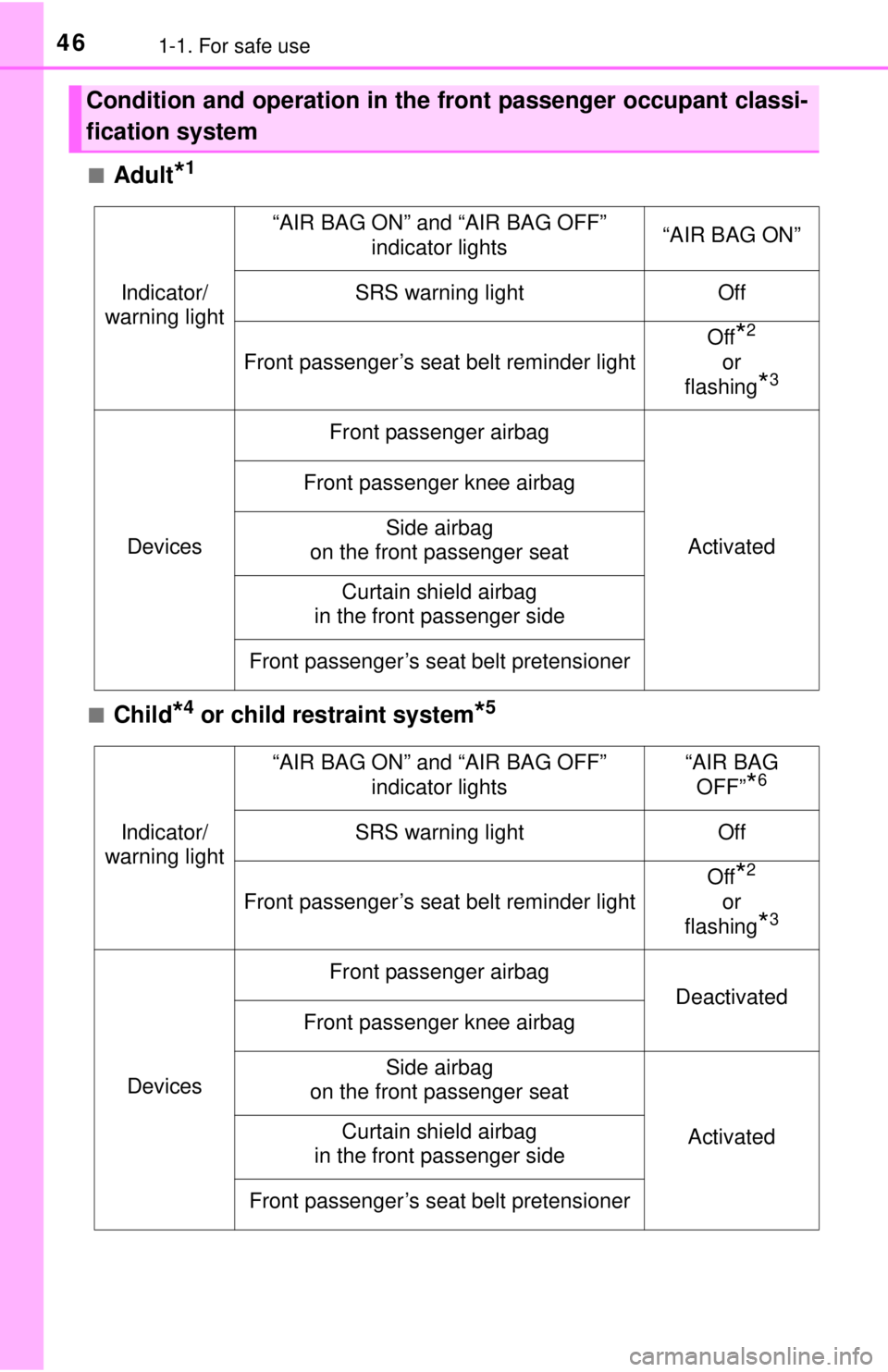
461-1. For safe use
■Adult*1
■Child*4 or child restraint system*5
Condition and operation in the front passenger occupant classi-
fication system
Indicator/
warning light
“AIR BAG ON” and “AIR BAG OFF” indicator lights“AIR BAG ON”
SRS warning lightOff
Front passenger’s seat belt reminder light
Off*2
or
flashing
*3
Devices
Front passenger airbag
Activated
Front passenger knee airbag
Side airbag
on the front passenger seat
Curtain shield airbag
in the front passenger side
Front passenger’s seat belt pretensioner
Indicator/
warning light
“AIR BAG ON” and “AIR BAG OFF”
indicator lights“AIR BAG OFF”
*6
SRS warning lightOff
Front passenger’s seat belt reminder light
Off*2
or
flashing
*3
Devices
Front passenger airbag
Deactivated
Front passenger knee airbag
Side airbag
on the front passenger seat
ActivatedCurtain shield airbag
in the front passenger side
Front passenger’s seat belt pretensioner
Page 48 of 640
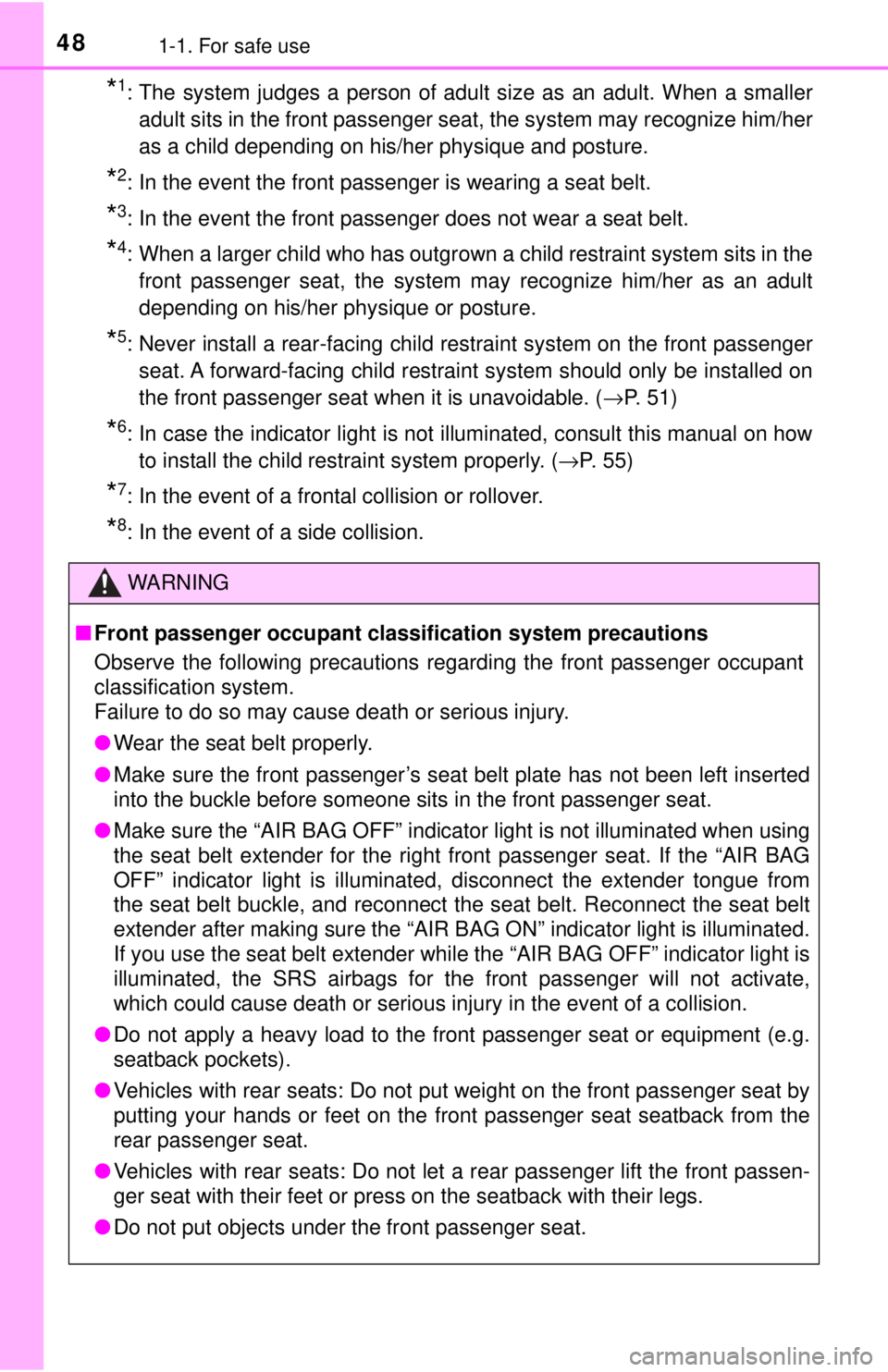
481-1. For safe use
*1: The system judges a person of adult size as an adult. When a smalleradult sits in the front passenger seat, the system may recognize him/her
as a child depending on his/her physique and posture.
*2: In the event the front passenger is wearing a seat belt.
*3: In the event the front passenger does not wear a seat belt.
*4: When a larger child who has outgrown a child restraint system sits in thefront passenger seat, the system may recognize him/her as an adult
depending on his/her physique or posture.
*5: Never install a rear-facing child restraint system on the front passengerseat. A forward-facing child restraint system should only be installed on
the front passenger seat when it is unavoidable. ( →P. 51)
*6: In case the indicator light is not illuminated, consult this manual on how
to install the child restraint system properly. ( →P. 55)
*7: In the event of a frontal collision or rollover.
*8: In the event of a side collision.
WARNING
■Front passenger occupant classi fication system precautions
Observe the following precautions regarding the front passenger occupant
classification system.
Failure to do so may cause death or serious injury.
● Wear the seat belt properly.
● Make sure the front passenger’s seat belt plate has not been left inserted
into the buckle before someone sits in the front passenger seat.
● Make sure the “AIR BAG OFF” indicator light is not illuminated when using
the seat belt extender for the right front passenger seat. If the “AIR BAG
OFF” indicator light is illuminated, disconnect the extender tongue from
the seat belt buckle, and reconnect the seat belt. Reconnect the seat belt
extender after making sure the “AIR BAG ON” indicator light is illuminated.
If you use the seat belt extender while the “AIR BAG OFF” indicator light is
illuminated, the SRS airbags for the front passenger will not activate,
which could cause death or serious injury in the event of a collision.
● Do not apply a heavy load to the front passenger seat or equipment (e.g.
seatback pockets).
● Vehicles with rear seats: Do not put weight on the front passenger seat by
putting your hands or feet on the front passenger seat seatback from the
rear passenger seat.
● Vehicles with rear seats: Do not let a rear passenger lift the front pass\
en-
ger seat with their feet or press on the seatback with their legs.
● Do not put objects under the front passenger seat.
Page 49 of 640
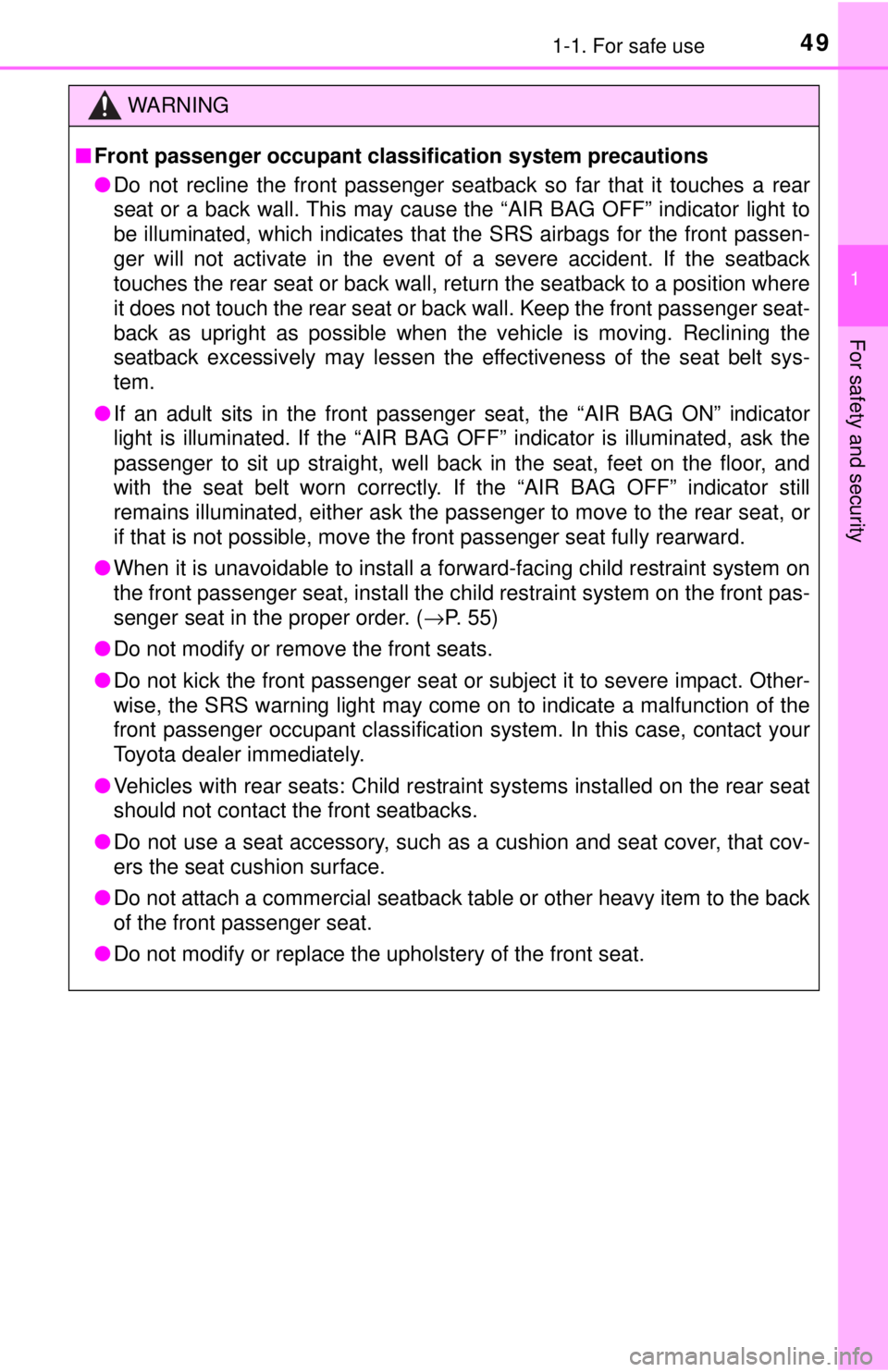
491-1. For safe use
1
For safety and security
WARNING
■Front passenger occupant classi fication system precautions
● Do not recline the front passenger seatback so far that it touches a rear
seat or a back wall. This may cause the “AIR BAG OFF” indicator light to
be illuminated, which indicates that the SRS airbags for the front passen-
ger will not activate in the event of a severe accident. If the seatback
touches the rear seat or back wall, return the seatback to a position where
it does not touch the rear seat or back wall. Keep the front passenger seat-
back as upright as possible when the vehicle is moving. Reclining the
seatback excessively may lessen the effectiveness of the seat belt sys-
tem.
● If an adult sits in the front passenger seat, the “AIR BAG ON” indicator
light is illuminated. If the “AIR BAG OFF” indicator is illuminated, ask the
passenger to sit up straight, well back in the seat, feet on the floor, and
with the seat belt worn correctly. If the “AIR BAG OFF” indicator still
remains illuminated, either ask the passenger to move to the rear seat, or
if that is not possible, move the front passenger seat fully rearward.
● When it is unavoidable to install a forward-facing child restraint system on
the front passenger seat, install the child restraint system on the front pas-
senger seat in the proper order. ( →P. 55)
● Do not modify or remove the front seats.
● Do not kick the front passenger seat or subject it to severe impact. Other-
wise, the SRS warning light may come on to indicate a malfunction of the
front passenger occupant classification system. In this case, contact your
Toyota dealer immediately.
● Vehicles with rear seats: Child restraint systems installed on the rear seat
should not contact the front seatbacks.
● Do not use a seat accessory, such as a cushion and seat cover, that cov-
ers the seat cushion surface.
● Do not attach a commercial seatback table or other heavy item to the back
of the front passenger seat.
● Do not modify or replace the upholstery of the front seat.
Page 50 of 640
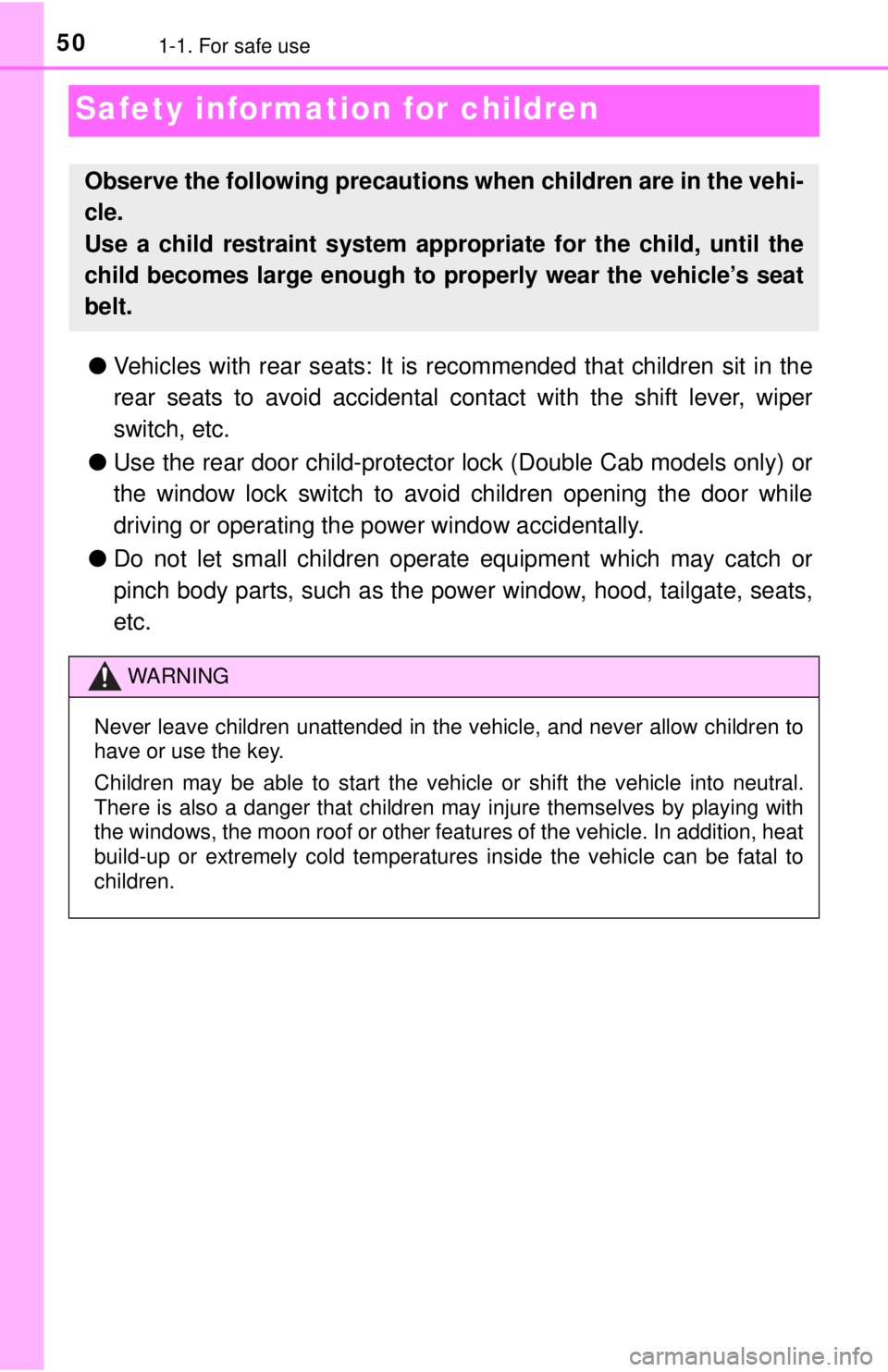
501-1. For safe use
Safety information for children
●Vehicles with rear seats: It is recommended that children sit in the
rear seats to avoid accidental contact with the shift lever, wiper
switch, etc.
● Use the rear door child-protector lock (Double Cab models only) or
the window lock switch to avoid children opening the door while
driving or operating the power window accidentally.
● Do not let small children operate equipment which may catch or
pinch body parts, such as the pow er window, hood, tailgate, seats,
etc.
Observe the following precautions when children are in the vehi-
cle.
Use a child restraint system appropriate for the child, until the
child becomes large enough to pr operly wear the vehicle’s seat
belt.
WARNING
Never leave children unattended in the vehicle, and never allow children to
have or use the key.
Children may be able to start the vehicle or shift the vehicle into neut\
ral.
There is also a danger that children may injure themselves by playing with
the windows, the moon roof or other features of the vehicle. In addition, heat
build-up or extremely cold temperatures inside the vehicle can be fatal to
children.
Page 51 of 640
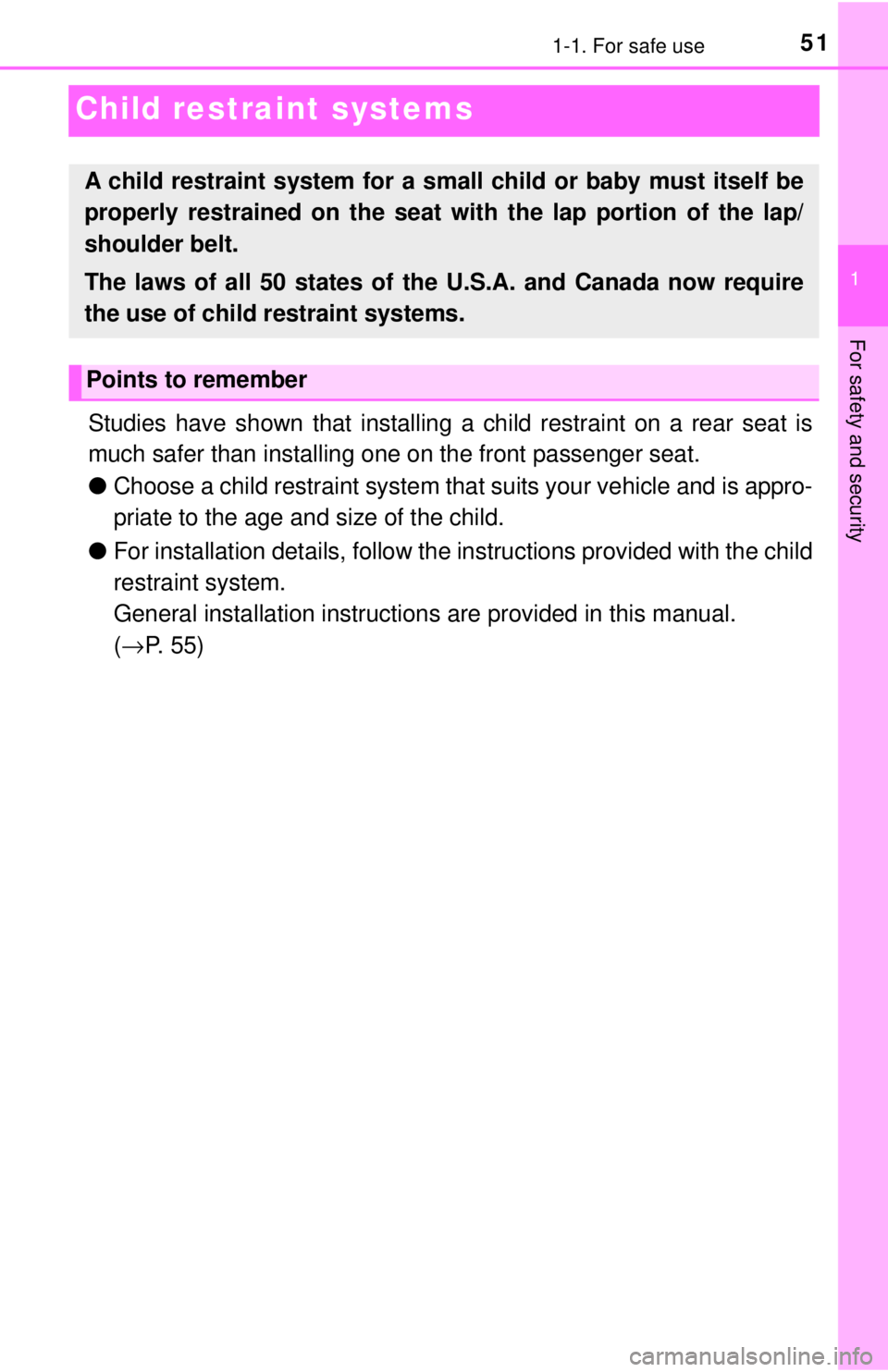
511-1. For safe use
1
For safety and security
Child restraint systems
Studies have shown that installing a child re straint on a rear seat is
much safer than installing one on the front passenger seat.
● Choose a child restraint system that suits your vehicle and is appro-
priate to the age and size of the child.
● For installation details, follow the instructions provided with the child
restraint system.
General installation instructions are provided in this manual.
( → P. 55)
A child restraint system for a small child or baby must itself be
properly restrained on the seat with the lap portion of the lap/
shoulder belt.
The laws of all 50 states of the U.S.A. and Canada now require
the use of child restraint systems.
Points to remember
Page 52 of 640
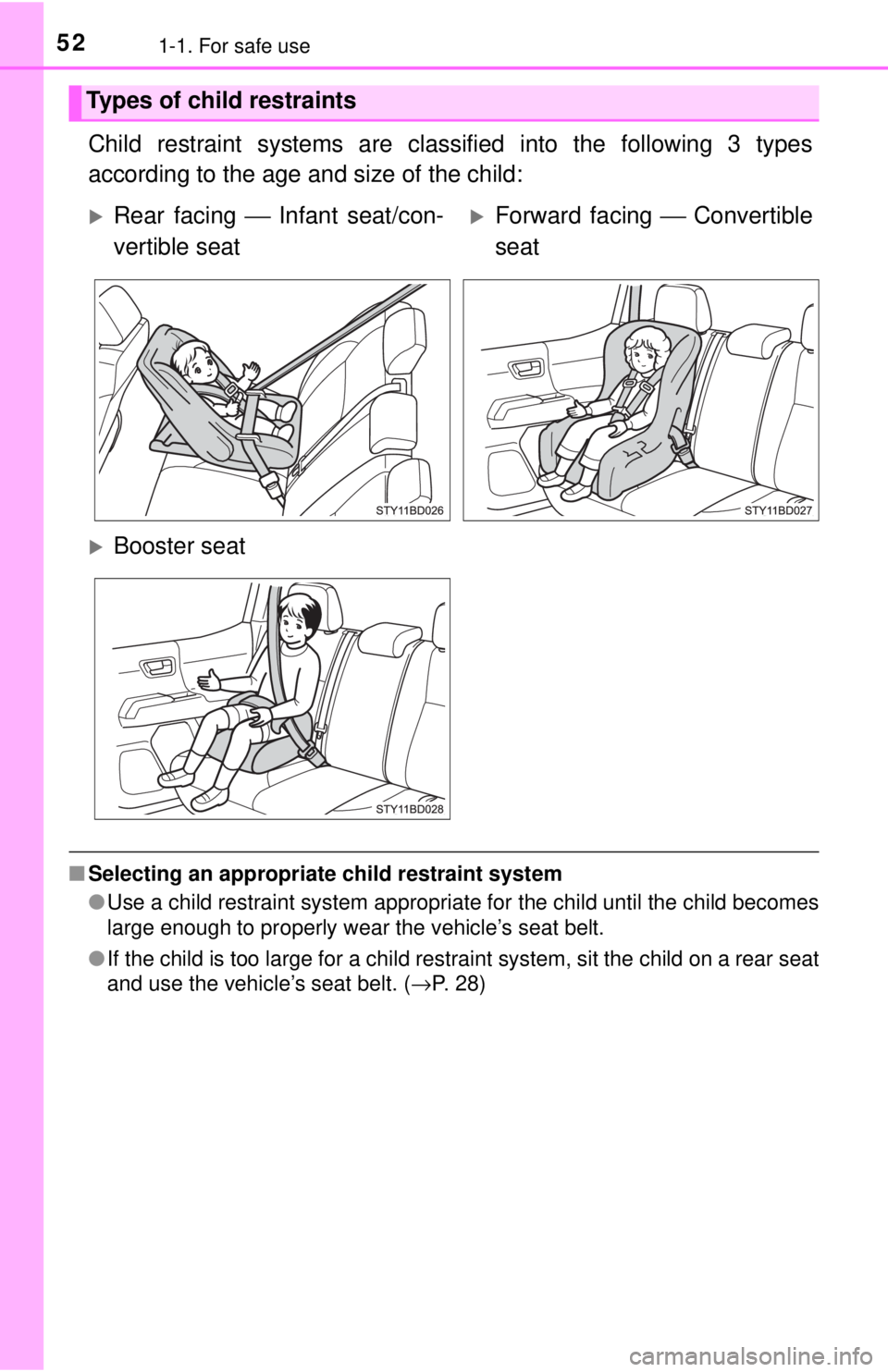
521-1. For safe use
Child restraint systems are classified into the following 3 types
according to the age and size of the child:
■Selecting an appropriate child restraint system
●Use a child restraint system appropriate for the child until the child becomes
large enough to properly wear the vehicle’s seat belt.
● If the child is too large for a child restraint system, sit the child on a rear seat
and use the vehicle’s seat belt. ( →P. 28)
Types of child restraints
Rear facing ⎯ Infant seat/con-
vertible seatForward facing ⎯ Convertible
seat
Booster seat
Page 53 of 640

531-1. For safe use
1
For safety and security
WARNING
■Child restraint precautions
● For effective protection in automobile accidents and sudden stops, a child
must be properly restrained, using a seat belt or child restraint system
depending on the age and size of the child. Holding a child in your arms is
not a substitute for a child restraint system. In an accident, the child can be
crushed against the windshield, or between you and the vehicle’s interior.
● Vehicles without rear seats: Toyota strongly urges the use of a proper child
restraint system that conforms to the size of the child.
● Vehicles with rear seats: Toyota strongly urges the use of a proper child
restraint system that conforms to the size of the child, installed on the rear
seat. According to accident statistics, the child is safer when properly
restrained in the rear seat than in the front seat.
● Never install a rear-facing child restraint system on the front passenger
seat even if the “AIR BAG OFF” indicator light is illuminated.
In the event of an accident, the force of the rapid inflation of the front pas-
senger airbag can cause death or serious injury to the child if the rear-fac-
ing child restraint system is installed on the front passenger seat.
● Vehicles without rear seats: A forward-facing child restraint system may be
installed on the front passenger seat only when it is unavoidable. Adjust
the seatback as upright as possible and always move the seat as far back
as possible even if the “AIR BAG OFF” indicator light is illuminat\
ed,
because the front passenger airbag could inflate with considerable speed
and force. Otherwise, the child may be killed or seriously injured.
● Vehicles with rear seats: A forward-facing child restraint system may be
installed on the front passenger seat only when it is unavoidable. A child
restraint system that requires a top tether strap should not be used in the
front passenger seat since there is no top tether strap anchor for the front
passenger seat. Adjust the seatback as upright as possible and always
move the seat as far back as possible even if the “AIR BAG OFF” indicator
light is illuminated, because the front passenger airbag could inflate with
considerable speed and force. Otherwise, the child may be killed or seri-
ously injured.